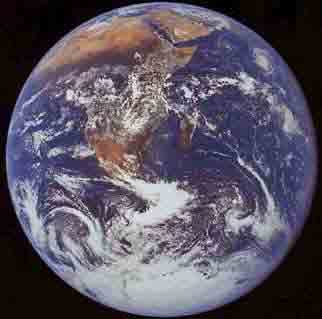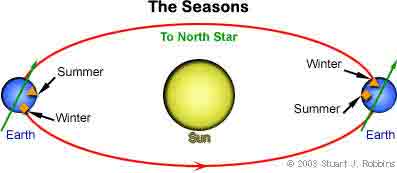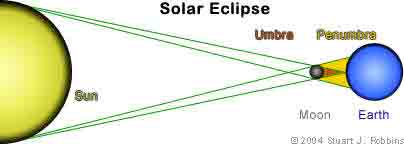|
         
> The Sun
> Mercury
> Venus
> Earth
> Mars
> Jupiter
> Saturn
> Uranus
> Neptune
> Pluto
> The 10th Planet?
> Asteroids
> Comets
> The 'Edge'
  
|
The Earth consists of
three distinct layers. The core is the central part. It is made of molten nickel and iron; their movement
generates Earth's magnetic field. The next layer is the mantle. It
consists of solid, hot rock. The crust upon which we walk and live is the
upper-most layer, consisting of soil, clay, and fine rock.
the central part. It is made of molten nickel and iron; their movement
generates Earth's magnetic field. The next layer is the mantle. It
consists of solid, hot rock. The crust upon which we walk and live is the
upper-most layer, consisting of soil, clay, and fine rock.
The atmosphere has five layers. The layer closest to the surface is called
the Troposphere. It is about 3.2 km (two miles) thick, and can contain low
lying clouds. The next layer is the stratosphere. The stratosphere is
about 21 km (13 miles) thick and contains the high cirrus and cirrostratus
clouds. The highest altitude commercial planes fly at this level. The
level above the stratosphere is the Mesosphere. Above the Mesosphere is
the Thermosphere. Combined, the Thermosphere and the Mesosphere create the
Ionosphere, which is 435 km (270 miles) thick. The last layer of our
atmosphere is the Exosphere, which extends into space.
Unique Characteristics
The Earth is the only planet, that we currently know of,
capable of sustaining life. Several factors led to the development of
life: First, Earth had to be at a temperate distance from its host star.
This means that the planet needs to be at a distance from the star to
allow liquid water to exist, and for the temperature range to be not too
extreme. Second, Earth has an atmosphere, and that atmosphere had (and
has) a chemical makeup that allows the development of life. Third, Earth
has water. Biologists believe that this is the most essential constituent
for life to exist. [Top]
The Seasons
If you were to talk to the average passer-by, they would
probably tell you that the seasons are caused by Earth not having a
perfectly circular orbit about the sun, so when it's farther away it is
winter and when it's closer it is summer. However, there is a simple
reason why this is incorrect: That would mean the northern and southern
hemispheres have winter at the same time and summer at the same time
(which they, in actuality, don't).
The explanation behind the seasons has to do with the Earth's tilt on its
axis. As shown in the data table below under "Axial Tilt," the Earth's
rotation axis is tilted approximately 23.5° from the plane in which it
orbits (this is represented by the green arrows pointing "To North Star")
in the above picture. This tilt results in parts of Earth receiving more
direct sunlight than other parts. When they get more direct sunlight, it
is warmer (Summer), and less direct is cooler (Winter).
In the diagram above, the triangle and diamond represent locations on
Earth. In the Earth on the left of the sun, the diamond is facing the sun
more directly, and it is experiencing Summer. The diamond is at a
less-direct angle and is experiencing Winter. In the Earth on the right,
the triangle and diamond are in the same location as before, but now the
diamond gets more direct sunlight and the triangle less direct, so their
seasons are switched.
It is because of this constant* axial tilt that different sections receive
different amounts of light at different times of the year, causing the
seasons.
The tilt of Earth's axis is relatively constant, but a process known as
precession causes the "North" to move over the course of approximately
24,000 years. For example, when the Egyptian pyramids were built, the
north star was not Polaris, but a star called Thuban. [Top]
Earth's Satellite
The moon is Earth's closest celestial neighbor. It has a
huge influence upon our lives, governs the tides (the sun plays a small
part, but not nearly as much as the Moon), and is responsible for
eclipses. Some biologists say that the moon is even responsible - in part
- for life on Earth, for without the tides causing currents and mixing of
chemicals, life might never have formed.
The moon lies, on average, 384,400 km (238,900 miles) away and takes 27.3
days to orbit the Earth. Strange as it may seem, its rotation period is
exactly the same as its orbital period, something that scientists call
tidally locked. Therefore, one half is always facing the Earth while the
other half is always facing away. This means that there isn't really a
"Dark Side" of the moon. Also, contrary to popular opinion, there have
been people on the far side, and it has been extensively photographed and
mapped. [Top]
Surface and Atmosphere
The moon has a very heavily cratered surface, which tells
the tale of solar system. Earth would be the same way if it had no
atmosphere nor plate tectonics. Without an atmosphere or water to erode
the craters, the lunar landscape has remained relatively constant for
billions of years.
It is through these craters that we can actually tell some of the solar
system's history. Through dating the craters, planetary scientists have
been able to determine that most of the craters were made in the early
days of the solar system, approximately 3.8-4.5 billion years ago. This
means that early in the solar system, there was a period of heavy asteroid
bombardment. This is most likely due to all of the extra material left
over from the solar system's formation. After approximately 1.2 billion
years, most of the material had formed into the Asteroid Belt, been
ejected from the solar system, or hit the planets and moons.
If you look at the moon closely, you can see dark patches. After the
period of heavy asteroid bombardment, the moon's surface cracked in many
places. The lowlands of the moon filled with volcanic material, which then
cooled. This lasted for approximately 750 million years. They are called
maria (singular is mare) due to their resemblance to dark oceans.
The moon has remained relatively static (unchanging) for the last 2.5
billion years, with the occasional asteroid impact. [Top]
Creation
There are four main theories about the creation of the
moon, although only one is generally considered to give an accurate
description of what actually occurred.
The first theory states that the moon was created the same way the planets
were - through the coalescing of gas and dust during the solar system's
formation. The second theory says that the moon is a captured asteroid.
The third theory says that when the Earth was first formed it was spinning
so rapidly that it split in two; this is often referred to the "fission"
theory.
The fourth theory is the one that most scientists currently believe is
correct. It states that when the Earth was quite young, a Mars -sized
planet crashed into it. The planet crashed with such speed that it was
completely destroyed, and almost destroyed the Earth. The planet was
coming in with such force that when it was destroyed, the molten iron in
its core continued to travel through Earth, to eventually be included it
its core. This explains why the Moon has very little iron. The crash,
comically dubbed the "Big Splash," sent tons of rock and debris into
orbit. These fragments eventually coalesced to form the Moon. The tidal
and rotational forces in play also account for why the moon's day is
exactly the same as it's "year." [Top]
Eclipses
Eclipses are caused by one celestial body passing in front
of another - in our case the moon passing between the sun and Earth or
Earth passing between the sun and moon. However, eclipses do not occur
every new nor full moon because the moon's orbit is tilted approximately
5° relative to the Sun-Earth plane. Because of this, the moon passes
through this plane only twice in its orbit, and it is rare that these
crossings correspond with a full or new moon.
A solar eclipse occurs during a new moon, when the moon is directly
between Earth and the sun, as per the illustration on the left, which is
not to scale. When this happens, the moon blocks the sun's light from
reaching Earth in two main ways.
The first is represented by the inner, darker triangle, and is where a
total eclipse will appear on Earth. If the moon is just the right size and
at just the right distance for it to block all of the sun's disk during a
total solar eclipse. Generally, a total solar eclipse lasts about 5
minutes. If the moon is not at quite the right distance - because its
orbit is an ellipse and not a perfect circle - then it will be too small
to cover the entire solar disk, and an annular eclipse will result.
The second manner that the moon blocks the sun's light is represented by
the two outer triangles in yellow. In these areas on Earth, there will be
a partial solar eclipse where the sun's disk is not fully covered by the
moon.
A fourth type of solar eclipse is a fairly rare event, and is called a
hybrid. It is when an annular eclipse is seen on one part of Earth and a
total is seen by another.
Lunar eclipses generally occur more often than solar eclipses, if for no
other reason than Earth's shadow is much larger at the moon's distance
than the moon's shadow on Earth. Other than it's the Earth casting a
shadow on the moon, lunar eclipses are exactly the same as solar eclipses.
The Earth lies between the sun and moon, and if the moon crosses the
Sun-Earth plane when it is full, then a lunar eclipse will result. The
first part is a partial lunar eclipse, as the moon begins to move through
Earth's penumbra. Then, if it is aligned just right, the moon will then
pas through the umbra, and go into totality. Totality during a lunar
eclipse lasts much longer - generally about 40 minutes - than totality
during a total solar eclipse.
During a total lunar eclipse, the Earth's atmosphere creates two very
noticeable effects. The first is that it causes the moon to appear red.
This is because the atmosphere scatters sunlight around Earth; shorter
wavelengths are scattered more easily, and so do not pass all the way
around Earth with nearly as much intensity as the shorter, redder light.
This effect hints at the second, which is that the atmosphere acts as a
lens to amplify the light that would reach the moon.
Therefore, without a terrestrial atmosphere, a lunar eclipse would appear
darker and not red. Also, the atmosphere has a blurring effect, so without
an atmosphere, the distinction between the penumbral and umbral shadows
would be much sharper.
[Top]
Tides
Tides are a very complex phenomena, yet they can be boiled
down to a few key concepts. The first to develop an accurate theory of the
tides was Sir Isaac Newton over 300 years ago. His theory, "The
Equilibrium Theory of Tides," is what will be discussed here.
First examined will be the relationship between just the Earth and Moon.
In the diagram at right is presented a top view of the Earth-Moon system.
This is not to scale, and the water bulges have been greatly exaggerated.
As theorized by Newton, every object exerts a pull on every other object.
As the moon pulls on Earth, Earth also pulls on the moon. Earth is so much
larger than the moon that it hardly moves at all, and the rock is so rigid
that it hardly deforms at all; however, the water flows much more easily.
Because of the pull from the moon on Earth's water, the water forms a
bulge on the moon-ward side. This is high tide.
Earth has a certain velocity as it orbits the sun, and this causes an
outward force. Just as the moon's gravity pulls the water and creates a
bulge towards it, the outward force also creates a bulge, but on the side
opposite the moon. Thus there are two high tides on the planet on opposite
sides at once.
There is another basic complication to this theory, and that is
represented by the arrows. The gray arrows pointing towards the moon
represent the relative force felt by different sections of Earth at
different distances from the moon. The close side of Earth is about 50
times Earth's radius from the moon, while the far side is about 52 times.
This creates a difference in the force, so the far side does not feel as
much of a pull from the moon. The green arrows pointing away from the moon
represent the force outward. Their strength is opposite to that of the
moon in direction. They are stronger on the far side of Earth and weaker
on the near side.
These act to create a net - total - force where on the side closer to the
moon the pull is to the moon and on the side farther from the moon the
pull is away from the moon. Conversely, there is a resultant inward force
in between these extremes, and this causes the low tides. As the moon
orbits the Earth, the tidal bulges move with it, making one revolution
every 24 hours and 50 minutes.
Now we add the sun. The tides caused by the sun follow the exact same
methods as those by the moon. In the diagram at the left, the light blue
bulge of water is caused by the sun's influence (purple-blue is from the
moon). The yellow arrows indicate the pull of the sun. Even though the sun
is so much larger than Earth, it is so much farther away that the
difference in the force between opposite sides of Earth is approximately
45% that of the Moons. Thus, the tides that would be produced by the sun
are approximately 45% as strong as those from the moon.
One final bit will finish the Equilibrium Theory of Tides. Moon and Sun do
not stay at fixed points relative to Earth. The moon orbits around Earth,
and Earth orbits around the sun. Therefore, the total effect of the sun
and moon act to create two high and two low tides per day, but they vary
in intensity. When the moon and sun are at right angles, as shown in the
picture at the left, the moon's tidal effects cancel out that of the
sun's, but as a result its pull is diminished, causing what are called
spring tides. When the sun and moon line up relative to Earth, the two act
together to create much greater high tides and much lower low tides,
causing what are called neap tides. [Top]
External Links:
[Back] [Top] [Next] |
 the central part. It is made of molten nickel and iron; their movement
generates Earth's magnetic field. The next layer is the mantle. It
consists of solid, hot rock. The crust upon which we walk and live is the
upper-most layer, consisting of soil, clay, and fine rock.
the central part. It is made of molten nickel and iron; their movement
generates Earth's magnetic field. The next layer is the mantle. It
consists of solid, hot rock. The crust upon which we walk and live is the
upper-most layer, consisting of soil, clay, and fine rock.
